Does the Moon Look the Same Everywhere?
No matter where in the world you are, you see the same Moon in the sky. But your location does make a difference in where, when, and how you see it—sometimes in surprising ways.
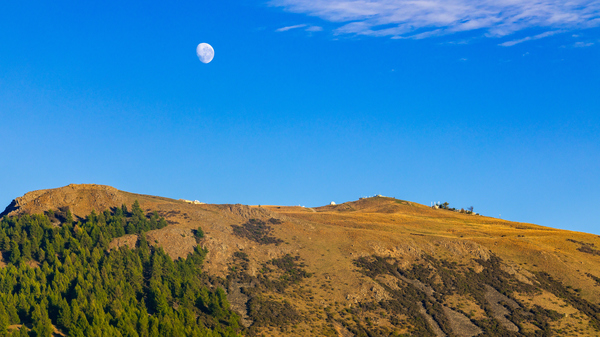
Waning Gibbous Moon, as seen from New Zealand: Your location determines when you get to see the Moon, and what it looks like.
©iStockphoto.com/Ernest Kung
Jan 2025: See the planets at their best
Is the Moon Upside-Down in the Other Hemisphere?
If you’ve ever crossed the equator and traveled to the opposite hemisphere, you might have noticed that the Moon looked different.
The phases of the Moon are the same, but they seem to play out in reverse; the waxing and waning happen in the opposite direction of what you’re used to.
And, if you look very closely at a Full Moon, you may notice that it looks strangely unfamiliar, the darker lunar lowlands on its surface no longer producing the pareidolic image of the Man in the Moon you’re accustomed to.
“I had my own lunar epiphany when traveling to New Zealand as a 16-year-old exchange student in the 1990s. My friends back home in Germany had teased me after I had speculated if the Moon would appear the other way around Down Under.
The first thing I did was send them a picture of the Waning Crescent Moon shining brightly in the sky above New Zealand’s green rolling hills, with the right side of the Moon’s face illuminated instead of the left.”
Konstantin Bikos
It may seem like a fantastical notion to those of us that have never contemplated or experienced it, but it is actually true: people in the opposite hemisphere really do see the Moon upside-down!
It’s You Who’s Upside-Down!
Of course, it makes sense if you think about it: as you move from one side of the planet to another, your orientation relative to things surrounding it in space changes, and you see them from the opposite point of view. In other words, it’s not the Moon that’s upside-down; it’s you!
This means that, technically, you also see the Sun, the stars, and the planets of the solar system upside-down—though that isn’t easily discernible for naked-eye observers. What you might notice is that asterisms or constellations, such as Orion or Aquarius, also have different orientations.
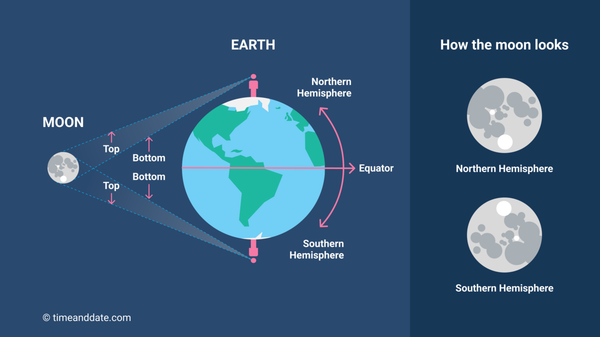

It’s not the Moon that’s the “wrong” side up—it’s you!
©timeanddate.com
Exactly Upside-Down Only at the Poles
That said, the Moon doesn’t appear flipped by exactly 180 degrees if you compare the view, for example, from North America with that from Australia. The Moon’s apparent orientation depends on your latitude. So, as you move north or south, it will appear to rotate by the angle equivalent to the degrees of latitude you cross.
Live Moon Phase
The real-time Moon phase simulation in our Moon Calculator shows the current Moon at a location of your choice.
Open the pages for different locations to compare the Moon’s orientation. Note that the Moon’s orientation also depends on the local time of day, so choosing locations on very different longitudes will skew the results.
For example, the difference in latitude between New York (USA) and Sydney (Australia) is about 73 degrees. So, the Moon will appear rotated by that amount to a Sydneyite visiting the Big Apple.
For the same reason, the Moon seems to “lie on its side” when viewed close to the equator, with the Crescent Moon sometimes appearing like a golden boat roaming the night sky.
The only places where the Moon’s disk will appear rotated by precisely 180 degrees are the North Pole versus the South Pole.
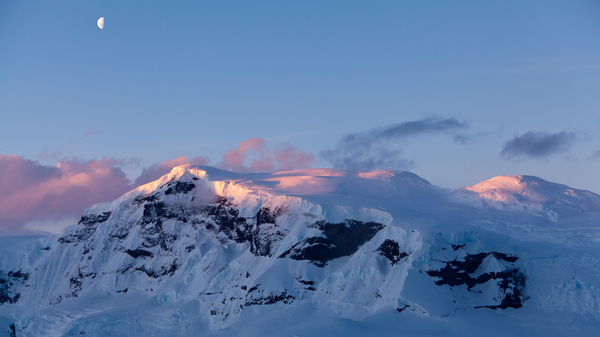
First Quarter Moon above Antarctica: in the southern sky, the Moon appears to wax from left to right, following the New Moon.
©iStockphoto.com/rwhitacre
Different Paths across the Sky
Another aspect that sets the Moon’s appearance in the Northern Hemisphere apart from its appearance south of the equator is how it traverses the sky.
Wherever you are, the Moon rises somewhere in the east and sets somewhere in the west, just like the Sun. But what happens in between depends on the part of the world you’re in.
North of the equator, the Moon rises at an angle that points toward the south, making it feel like it travels from left to right; in the Southern Hemisphere, it goes north after moonrise, and it looks like it is moving from right to left.
Close to the equator, the Moon rises vertically and passes overhead, hardly deviating north or south, until it vertically drops below the horizon in the west; at the poles, it effectively circles around you on a horizontal path, though it stays below the horizon for about half of each lunar month.
See it for yourself in our Night Sky Map by comparing the Moon’s path today in France (Northern Hemisphere) to its trajectory in Ecuador (close to the equator), in New Zealand (Southern Hemisphere), and at the South Pole!
How can the Full Moon be during the daytime?
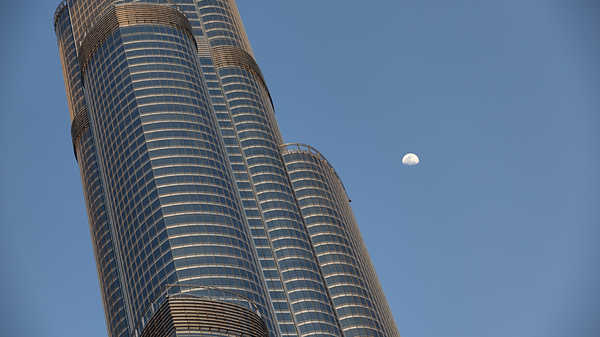
Third Quarter Moon in Dubai, UAE: close to the equator, the Moon appears to “lie on its side.”
©iStock.com/35007
Later in the West
Your location also determines when and where the Moon rises and sets.
When you see the Moon depends largely on the longitude (your position on an east-west axis). Moonrise happens when the Earth’s rotation brings the Moon into view from your position. Naturally, this occurs at radically different moments depending on which side of the globe you’re on.
In fact, you don’t have to travel to the end of the world to experience that effect. Just a few miles to the west of where you are, the Moon rises and sets a bit later than at your current location.
Moonrise and moonset happen about an hour later in Indianapolis than in Boston, which is around 1300 km (800 mi) away; the difference between Madrid and Warsaw, bridging a distance of roughly 2300 km or 1400 mi, is about two hours.
By the way, that’s also the reason why ocean tides happen at different times around the world.
That said, compared to the local time, moonrise and moonset times don’t vary much from one place to another: for example, a First Quarter Moon will always rise around noon and set around midnight in each time zone. That’s because the Sun’s apparent movement across the sky, from which we ultimately derive our local time, is primarily caused by the same mechanism as the Moon’s: the Earth’s rotation.
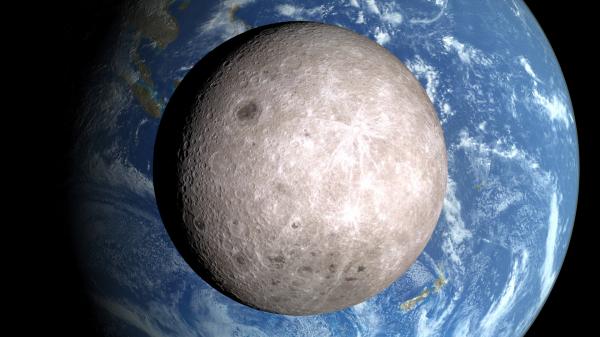
The Moon's far side remains invisible to us, regardless of our location on Earth. That is unless a spacecraft snaps a picture of it, like the one you see here!
©NASA/LRO
Nobody Sees the Far Side
One thing Moon gazers in all corners of the Earth have in common is the part of the Moon we see.
The Moon’s orbit and rotation are tidally locked to each other, meaning that the same side of the Moon always faces us. (That said, an effect called lunar libration brings a small fraction of the Moon’s far side into view over time.)
Exhibit A: Our Eclipse Livestreams
A fun way of verifying all this is following one of our lunar eclipse livestreams. They usually feature a number of live video feeds from several far-apart locations, making it easy to compare the Moon’s orientation and appearance as seen from different parts of the world. Read more about the factors involved in changing the Moon’s orientation on-screen
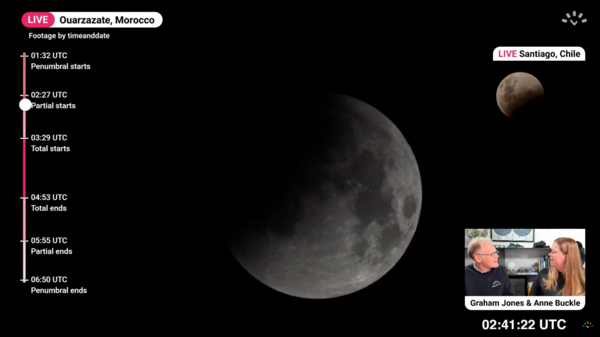
Our lunar eclipse livestream from 2022: Note how the feed from Morocco shows the eclipse shadow advancing in a completely different direction than the image from Chile.
©timeanddate
As the lunar eclipse progresses and the Earth blocks the Sun’s light from reaching parts of the lunar surface, you can witness how the Earth’s shadow creeps across the Full Moon in different directions.
And yet, each camera is filming the exact same scene—just from different angles.